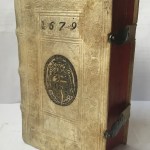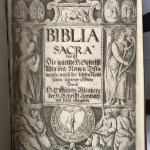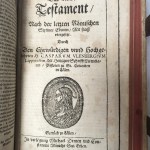GERMAN BIBLE. Biblia Sacra, das ist Die gantze H. Schrifft Alten und Newen Testaments.
Köln, In verlegung Michael Dehmen und Wittib Constantini Munichs, 1666.
£2000
8vo, pp. (lxiv = title page + table of contents), 844 (Old Testament), a-3f8 3g6; pp. 368 (Prophets), a-z8; pp. 324 (New Testament), 2a-2y8 2×2; pp. 52 (Apocrypha), *-3*8 4*2. Gothic letter, a little Italic. Double column, framed text, ruled in black, with side rows for notes; Apocrypha in single column. Decorated initials, capital spaces with guide-letters, head and tailpieces. Title within architectonical border in compartments: Moses and Salomon to the sides; six biblical scenes at head of page (from left to right: Creation, Adam and Eve, Original Sin, Binding of Isaac, Moses receives the Law on Sinai, Christ Pantocrator) with putti holding cartouches with bible verse to the very top: “vidit Deus cuncta quae fecerat, et erant valde bona, Gen. I”; at foot, central image of Crucifixion and “haurietis aquas de fontibus Salvatoris Isa. 12” inscribed around in circle. The four Evangelists while writing the Gospels (Luke and Marc to the left, Matthew and John to the right) and imprint in a large gothic-style cartouche at foot with motto “labore et costantia” in cartouche entwined with architectural compass. In clean contemporary German blind-tooled pigskin over wooden boards, date “1679” stamped in black to top of front board, with original brass clasps and catches. At centre of boards within panels, large black-ink oval coat of arms of the Austrian Cardinal Maximilian Gandolph von Künburg (1622-1687) with date of his ordainment, “1668”, inscribed in it. Early ms. note on front pastedown: “Collegiatum in Seekirchen” and modern stamp of the collegiate library of Seekirchen (Austria) on verso of t-p. An excellent, fine copy and extremely well-preserved. A.e.r.
Second edition of this Catholic bible in German language, which was translated by Kaspar Ulenberg (1549–1617). Ulenberg was a Catholic convert and a prolific theological writer, who studied theology at Wittenberg. While studying Luther’s writings there, his first doubts as to the truth of the Lutheran doctrines were awakened, and were then increased by hearing the disputes between the Protestant theologians and by the appearance of Calvinism in Saxony. One day he was then sent by his family to Cologne to convert to Protestantism a relative of his who had become Catholic. After accomplishing this task he remained in Cologne, where, through some Catholic friendships, he had an opportunity of becoming acquainted with Catholic life and teaching. In 1572 he became a Catholic, and soon afterwards, upon obtaining degrees in philosophy at the University of Cologne, he laboured zealously by preaching and catechetical exercises, and made many conversions.
This work is his last and most important literary achievement, which he began around 1614 at the request of the Archbishop and Elector of Cologne, Ferdinand Duke of Bavaria, and finished shortly before his death. The first edition appeared at Cologne in 1630; eleven other editions were published at Cologne up to 1747, and eleven more at Nuremberg, Bamberg, Frankfort, and Vienna. The present work bears the armorial shield of the Austrian Cardinal Maximilian Gandolph von Künburg (1622-1687), who was nephew to the famous Cardinal Wolfgang Hanibal von Schrattenbach. Maximilian established the monastery of Seekirchen am Wallersee in Austria, a town in the Salzburg lake district, in 1679 and one can suppose this bible was donated by him to the collegiate library of the monastery, since in bears the date of foundation stamped on its front cover.
Not in Darlow-Moule and the bibles catalogue of the Württembergische Landesbibliothek, Stuttgart. This Bible, first published in 1630, “far outstripped all previous Catholic translations in terms of both greater correctness and linguistic versatility” (Wetzer-W., XII, 188).








